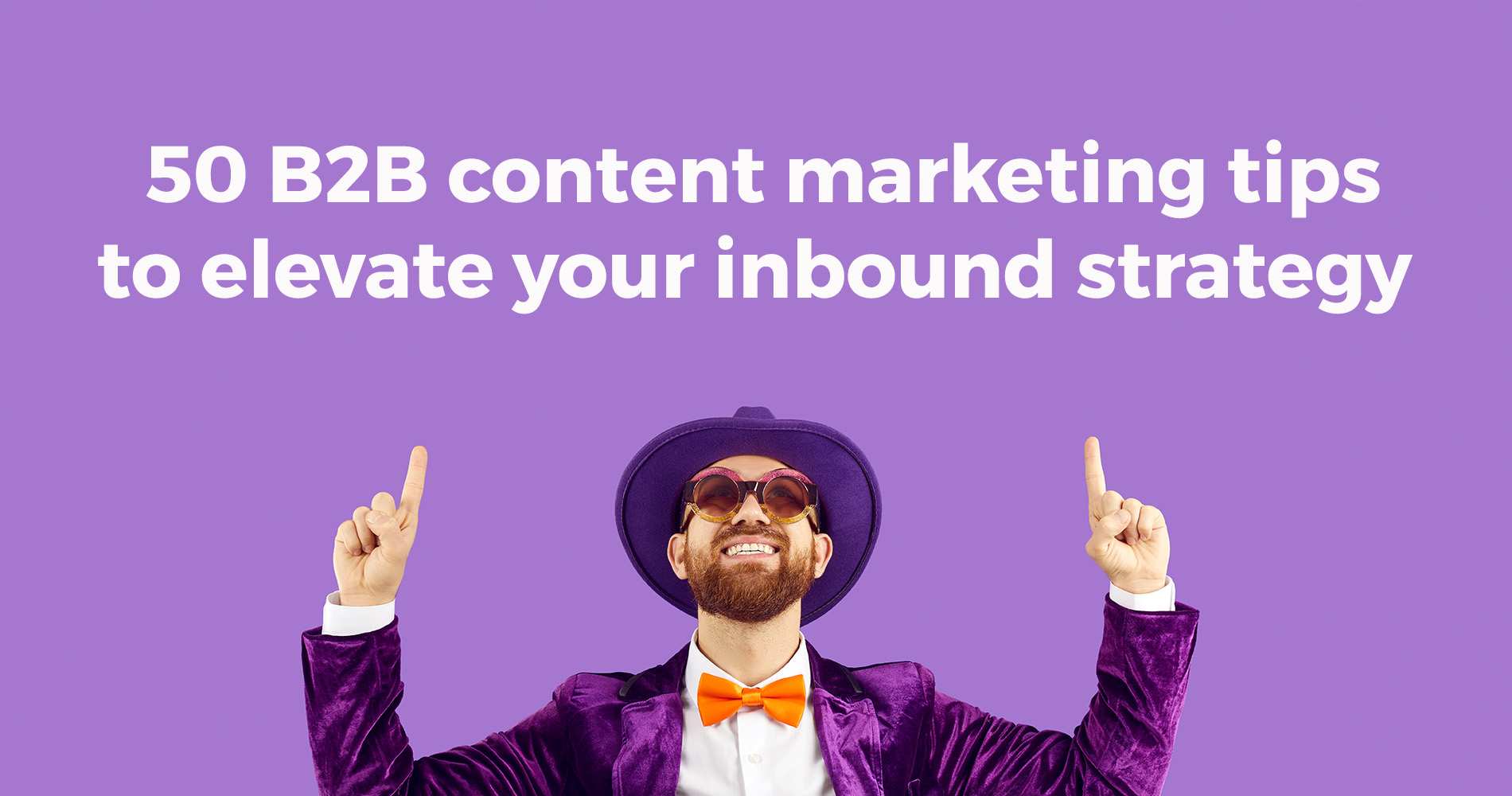Search engine optimisation (SEO) is in a constant state of flux. As search engines update their algorithms, B2B marketers must stay abreast of the latest SEO DOs and DON'Ts to maintain their rankings and visibility. To help you keep up with the ever-changing SEO landscape, we’ve compiled our top tips for successful B2B SEO.
A changing B2B SEO landscape
Google is always evolving with its algorithm, making subtle changes that are not as drastic or noticeable as the big updates such as Hummingbird and Panda. This continuous cycle ensures a more stable and reliable experience for its users. The COVID-19 pandemic has led to a steep rise in online usage, making SEO more indispensable than ever before. With Google continuously modifying its algorithms, staying on top of the latest SEO trends and techniques is essential if you want your website to succeed. It is important to stay abreast of the latest developments to remain competitive.
1. DO: Monitor performance with analytics
Optimising your website for search is an essential part of improving its visibility and rankings. Knowing which keywords to target is the first step toward successful SEO. Luckily, there are a variety of tools available that can help you identify the most appropriate keywords for your website. We recommend SEMRush, Moz, or Ahrefs as efficient and reliable options to get the job done quickly and accurately.
Top Tip: Focusing on specific, relevant phrases with low difficulty scores can be a great way to improve organic traffic. These are generally high-value, yet low-competition keywords that provide more bang for your buck.
Once you have completed your SEO optimisation activities, it is important to track the performance of your keyword analytics. This will allow you to spot any opportunities that arise and take action when needed. By tracking your keyword analytics over time, you will be able to identify which phrases need attention and make adjustments as necessary. This will help ensure that your website or content remains up-to-date and relevant for search engine rankings.
2. DO: Optimise your content with keywords
Make sure to include your primary keyword in the title and meta title of your page to increase visibility on Google search results. You have a limited amount of space for the display of your page's title, about 600 pixels, so make it count! Aim to keep the title content limited to 55 characters to be sure it is safe. This length will still give you enough room for your main keyword and an enticing title.
Top Tip: Are you looking for a way to save space when writing your meta title? Consider using a pipe! A pipe is a symbol that divides two distinct parts of the text to make them more concise. With this technique, you can easily create effective titles that are descriptive and concise. Not only does this save space but it also makes your title more eye-catching, making it easier for potential readers to find and click on. Try using pipes in your meta titles today and watch the difference it can make!
When it comes to writing effective body copy for B2B SEO, simplicity and specificity are essential. Content should be relevant to the topic area and avoid extra information that does not add value. Focusing on quality over quantity will ensure that your content is optimised for search engine ranking and provides a positive user experience.
Keep in mind that search engines can now recognise context and interpret conversational language. This renders the need for repetition of an exact keyword or phrase obsolete. Utilising various keyword variations, long-tailed keywords, and expansions are highly recommended for optimal performance.
3. DO: Link to relevant sources
Links are an essential part of web content and SEO, but it is important to use them strategically and with caution. Having a few well-chosen links to relevant internal pages and trusted external sources can add value to your content, while too many links can make your content look spammy and lead to a bad user experience. By using quality links in the right places, you can improve the authority of your website and ensure that your readers can find the information they need.
Top Tip: To keep users on your website for longer, make sure to open external links in new tabs. This way, you can ensure that visitors stay engaged and navigate back to your website with ease.
Effective internal linking should be a priority for any B2B business. Link specific keywords to your target pages, and make sure to prioritise the linking of your pillar, product, and service pages for optimal SEO results. This can significantly help in improving website visibility and rankings online.
When it comes to optimising online searches, fresh and relevant content reigns supreme. Keeping up with the latest trends and changing algorithms helps ensure that your website is visible on search engines and achieves maximum reachability.
Google has refined its algorithm to detect and prioritise websites with a “freshness value” that indicates how recently the content was updated. Links from such pages are highly valued as they bring more relevance, authority, and trustworthiness to Google's users. This freshness value can be an invaluable asset for any website looking to gain organic traffic from search engines.
CHECK OUT THIS ARTICLE: Topline SEO Guide for your CEO
4. DO: Optimise images with alt text
Having a website is no longer enough to stand out in the digital world. To be noticed by search engines, it is essential to include visual content with proper labelling and tagging. Adding 'alt text' with visuals can make all the difference when it comes to visibility on search engines. A few words will do; this simple yet effective tactic can help your website reach more people and stay ahead of the competition.
Alt text should prioritise accessibility to ensure that visually impaired user can understand the image. Although including a primary keyword can be beneficial in terms of SEO, there's more to this than just SEO value. To optimise your alt text further, provide additional detail beyond the keyword phrase.
Conducting B2B SEO without relying on stock images can be a challenge, but you don't have to give up. Tap into your creativity and think outside of the box. Let your imagination run wild and brainstorm ideas for potential visuals.
5. DO: Create relevant content
Making SEO effective for your B2B audience can be quite straightforward. All you need to do is to produce content that will be of interest to them and that is pertinent to their needs. This way, you'll ensure your customers have a quality experience every time they come across any content from your business.
The inbound marketing approach emphasises the importance of creating outstanding content that will draw more customers to your business. Quality content is essential for success in this methodology!
Writing content that is both quotable and shareable is an effective way to get backlinks from other sites. Creating shareable content with interesting facts, quotes, and stories gives readers something memorable to share with their friends or colleagues. This ensures that your content reaches a wider audience, increasing the chances of other websites linking back to you as a source of valuable information.
6. DO: Use Core Web Vitals for site optimisation
Mobile devices are dominating the web and as a result, Google puts more effort into promoting mobile-friendly and responsive websites. To ensure your website doesn't lose its ranking position, taking note of Google's Core Web Vitals is essential to maintain your SEO performance.
Also, Having a website with a responsive design is essential to ensure the success of B2B businesses. A website that responds quickly and efficiently to different user interaction requirements is an absolute must. Not only does it make the website more user-friendly, but it can also result in lower bounce rates - and lower bounce rates translate into better SEO results. The combination of a well-designed, easy-to-use website with improved SEO ensures customers will find you more easily and stay longer once they’re there.
7. DO: Remove low-quality inbound links
Search engine optimisation (SEO) is a vital part of any successful digital marketing strategy, but it can be easily undermined by third-party sites. If other websites link to your content with poor quality content, or if their SEO ranking is low, then you could be penalised by search engines. This can have a serious impact on the success of your SEO and it’s important to take steps to protect against this.
Taking control of your SEO starts with disavowing harmful links. By doing this, you're telling Google not to factor them in when evaluating your rankings. Therefore, it's important to take advantage of this useful tool to get the best and most accurate position on SERPs.
8. Don't: Overlook the intent of user searches
Serving a user's intent is Google's prime objective when it comes to delivering search results. This is why we believe that optimising for the buyer journey should be given utmost priority in any B2B SEO approach.
In today's digital world, understanding and serving a user's intent is key to any business's success. Google’s search engine optimisation is based on this very principle of delivering relevant search results to its users. In the B2B arena, optimising for the buyer journey should be given utmost priority as it ensures that potential customers find the desired information quickly and easily. With this in mind, businesses can ensure they are providing their customers with an optimal experience while increasing visibility and conversions in the process.
When users come to your site, they should get what they are looking for. Give them informative content if they are looking for information or direct them to the product/service page if they want to buy something. If a search query leads them to your page, make sure you own your own brand's navigational query.
It is not uncommon to make the wrong search intent when using informational keywords. For instance, diverting them to product or service pages instead of educational ones can be a problem. Especially for keywords like "advantages of visualisation software". Content on the page should be tailored to capture someone's interest and engage them in purchasing. Otherwise, one can expect to see a higher rate of visitors leaving the page quickly, low attention spans, and limited conversions from organic search.
YOU MAY LIKE THIS POST: What's The Difference: Inbound Marketing V SEO
9. Don't: Repeat external content in large chunks
Recycling your content can be an efficient way to use your resources, however, plagiarism is not permitted. It is important to take caution when you are reusing content so that you don't unintentionally mimic another person's material.
Search engines prefer unique, original content and will typically rank it higher than any duplicated or copied material. For B2B businesses that operate in a relatively static environment where there are limited changes, coming up with fresh ideas can be difficult. If your content isn't quite connecting with your audience, it might be time to try something new. Consider reworking it in a way that is more captivating and able to draw your buyers in.
The syndicated content presentation has become popular in recent times. If used the right way, it can prove to be beneficial for you as third-party sites host your blog posts on their website, thereby helping to jumpstart traffic from their readers. Alternatively, we strongly suggest producing unique digital content, as this will ensure the highest standard for your website's content.
10. DON’T: Overlink to external sites
Outbound links are an important part of content marketing, but too many can have a negative effect. When excessive outbound linking is used, it can make content harder to read and result in higher bounce rates – something that search engines will pick up on. As such, it is important to be mindful when using outbound links as they can have a significant impact on the success of your content.
11. Don't: Use keywords excessively
In this age of digital marketing, one of the greatest challenges is creating content that will attract customers while still being search engine friendly. Despite what many people think, overusing a keyword in content can harm conversions and engagement. While Google may not directly penalize websites for keyword stuffing, it can lead to a decrease in user satisfaction and conversions. Search engines are looking for content that has a clear theme and provides value to readers. As such, copywriters need to find the right balance between using keywords effectively while still keeping their content interesting and engaging.
Top Tip: Employing synonyms and associative words can be beneficial for search engines to comprehend the subject of your post, without making any impact on how readable it is for readers.
- DON’T: Leave it to chance
Keeping up with the ever-changing landscape of B2B SEO requires businesses to stay ahead of the game by implementing effective strategies and reviewing their content regularly. Developing an effective B2B SEO plan should involve routinely assessing and adjusting content to maintain accuracy and stay up to date. By continuously monitoring for changes in search engine algorithms, businesses can identify opportunities for improvement in their SEO performance. With a well-thought-out plan, businesses can make sure that their content is always current and optimised for maximum visibility in organic search rankings.
When you go over your content, cross-reference it with the keyword research you have conducted to ensure that you have not left out any subtopics. Additionally, make sure that the facts and figures presented are still up to date. For pages with product/service options, guarantee that the offers listed are correct and fresh features are included.
SEO remains valuable in B2B Marketing
SEO is a powerful tool for any business looking to attract more customers. But it can be a painstaking effort that requires significant time and resources. That’s where our tips will help you; these quick-and-easy inbound marketing techniques are the perfect way to give your SEO efforts a boost without breaking the bank. Utilising these snapshots as part of your inbound marketing strategy can help you quickly improve your SEO rankings with minimal effort. So, take advantage of this efficient tool now and start seeing results!




